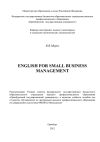Текст книги "The org board. How to develop a company structure"

Автор книги: Александр Высоцкий
Жанр: Малый бизнес, Бизнес-Книги
Возрастные ограничения: +12
сообщить о неприемлемом содержимом
Текущая страница: 6 (всего у книги 17 страниц) [доступный отрывок для чтения: 6 страниц]
Chapter 9
The fast flow system
Once you’ve accomplished the accurate separation of functions in an organization, the next step is to ensure their well-coordinated interaction. Business founders fall into a trap in this area very quickly, which leads to their overload. We could say that overload is a natural, as in the beginning the executive personally handles all the particles[23]23
Particle – 1) is (small) piece of something; part, portion or division of a whole. For example, when two boys are throwing a ball back and forth, the ball is a particle that being interchanged. 2) Any of the items handled by a person in the course of doing a job, such as an item used in producing a product. L. Ron Hubbard.
[Закрыть] to obtain products: all incoming documents and clients, he organizes the delivery of goods or execution of work, and closes deals. After some time, he gets assistants and delegates some part of his work to them. He hires a receptionist, who deals with documents and incoming calls, and a salesperson to work with clients. However, the particle flow is still distributed by the executive. With the growing number of assistants, the particle flow handled by the executive is getting bigger and bigger, despite the fact that his employees have certain functions. Eventually, it becomes so big that the executive is completely swamped with hundreds of different particles.

You might be familiar with the situation where your work commute is when make plans or determine the priorities for the long-term success of the company. However, when you arrive at the office, you find yourself buried under a mountain of «urgent issues» and your plans fall to the background. At the end of the day, when such an executive looks away from his desktop, he can't even remember what he did that day and he’ll have to address the most important tasks after employees went home for the day.
Inability to handle priorities, as well as hundreds of attention-consuming incidental issues, result in stress. Stress is a condition where you feel that if you have one more particle that needs to be handled fall on you, you'll just explode. You just want to lock yourself in your office and clean up the backlogs. Some executives will literally have to hide at home or in the office to get done what they had planned. The cause of this condition is an improperly organized particle flow that amplifies many times over as the company grows, but continues along the same route. The more particles pass through the executive, the more he becomes overloaded. Sooner or later, he’ll fully stop company expansion in order to keep his sanity and survive.
Once, I was consulting for the head of a company that developed software for accounting automation. In my work with him, I noticed that during his breaks, he could not tear himself away from the computer. It turned out that he received more than 150 emails a day. I observed this for some time and then I decided to find out what were those particles that he had to handle. He said that when his company had consisted of just a few programmers, they had decided to copy each other on important messages related to work projects for coordination purposes. In the beginning, perhaps, that was a good idea and helped them to coordinate. But the company gradually grew while this practice to CC each other on messages remained. After a few years, the executive had to view over a hundred messages a day, most of which had nothing to do with his functions.
In an organization, there are two completely different types of lines for particle exchange. The first type is called a "command line". This is a line that carries orders and reports, and that executives use for control (in the meaning that was discussed in the previous chapter). The second type is a "communication line". This carries particles that are handled by various employees in the course of their regular work.
Command lines go from top to bottom through the entire chain of executives. Communication lines go directly from one employee to another. If a CEO wants a salesperson to change something in his work with certain clients, he issues an order that goes through the sales manager, who gives the order to the salesperson and obtains compliance. When the compliance report is received from the salesperson, the sales manager verifies it and sends it up to the CEO. Particles, initially in the form of an order and then as a report, travel on a command line from top to bottom and from the bottom to the top.

If a salesperson needs to have information on the value of goods already delivered to a client, he directly addresses the employee who keeps shipment records, and then, through the same, way he receives a response back. In this case, a communication line is used. When an executive needs to get some equipment from the warehouse, he sends a request to the warehouse in accordance with the company policy, and then receives what he needs directly. This is a communication line as well.
I would like to bring to your attention one important point, which is especially relevant for small companies, where employees combine many functions. If a particle comes from a higher executive, employees tend to think that it came down the command line. They follow this simple logic: if it came from an executive, then it must mean command line, they need to drop everything, and start handling the particle immediately. The CEO simply wanted to find out how the products in a particular category were moving. He simply requested the data he needed for his work for some reason and did not mean to pressure the sales department. In most companies, this information request will go through the VP, then through the department executive, and on its way back, the report will go via the same route. As a result, this request will involve two more executives who will waste their time shuffling paper or contemplating why the CEO would make such a request. This is an error. If answering such requests is part of an employee’s regular duties, it should move along a regular communication line – from executive to employee, and back.
If you take a look at the seven division org board, it is easy to see that the Division of Production has the least tendency to hand over to an executive unfinished particles. For example, in a construction company no one thinks to ask the CEO to finish pouring a foundation or paint a wall. But in administrative areas, such as sales, it is common to bring a pending sale, with a client asking for a discount, to the executive’s desk. Or for the HR manager to dump on the executive’s desk a pile of resumes of pre-selected candidates and ask him to make the final choice. Surprisingly, it's essentially the same thing, "Please finish painting the fence for us, boss!"
When I first learned about communication and command lines from an article by L. Ron Hubbard[24]24
L. Ron Hubbard’s article «Making An Executive», written on April 1, 1972.
[Закрыть], I decided to analyze which particles I, as the CEO of my company, had to handle. The result of this analysis shocked me. I found that I spent at least 60 % of my time on work that had nothing to do with my responsibilities as an executive. This time was spent dealing with communication particles that could move directly from one employee to another, not via me.
A good tool to accurately identify the types of particles and, therefore, the lines they belong to, are various standard document formats. This allows one glance to understand what kind of particle this is. If this is an order, it should clearly say "Order", and everybody understands that this is a command line. If it says, "Request for Stationary Form”, this is a communication line, regardless of who filled it out. There could be dozens of standard forms, and sometimes I hear from executives that this will add “red tape” to the business. But think about how much the company loses because employees can’t quickly and correctly identify particles. Lines are mixed up and, as a result, executives are overloaded. It does not matter, whether the document exchange occurs in electronic or paper form – the principles remain the same. Electronic documents, of course, allow particles to move faster and each particle can be better controlled, which is very convenient.
In our company most of the communication takes place via email, and to make it easier to use the fast flow system. There are certain rules for composing messages:
1. A message must specify from what position and to whom the message is being sent. An employee may be responsible for several different functions, so when he receives an email, it must be clear to him which post the messages relates to. For example, I am an executive, a lead consultant, and sometimes a speaker. So when I receive my mail, I need to be able to see to what position the message is addressed; that determines what I will do with the message.
2. The type of message must be specified: order, compliance report, informational message, query, or something else.
3. The subject must be clearly stated, so that later you can easily locate this message.
4. The message itself should be composed where you don't have to guess what to do with it. Even if this message is addressed to me, I require that the sender indicate exactly what he expects from me. By the way, these rules lead up to yet another point that is less obvious – ”CCing” is not allowed. Very often, the person who was copied on a message is at a complete loss about why it was sent to him, and what is expected of him. If someone needs to be informed about the content of a message, a copy is sent to him directly, specifying that it is for his information on a particular issue.
To somebody who does not understand how an organization is set up, such rules may seem contrived, or he may feel that this is “red tape". By red tape we mean a situation where managers and employees are very keen on formalities and hide behind them, neglecting their jobs. A red tape situation does not occur because a company uses various document forms, it occurs because particles move through confusing routes that contain unnecessary vias. This stops production, and,even the most routine actions, require extraneous approvals.
«So long as command line is confused with the comm line an org will not produce much of anything but paper»[25]25
L. Ron Hubbard’s article «Making An Executive», written on April 1, 1972.
[Закрыть], – L. Ron Hubbard.
Imagine each employee in order to perform his duties has to interact with other employees of the organization. In this case, particles will move quickly, operating expenses will be minimal, and the level of production – maximal. Perhaps this immediately raises a question for you, how will the executive stay up to date, if all particles travel directly between employees? If you have to ask this, I have bad news for you – you don’t have a grasp on the executive tools. Imagine if Henry Ford tried to manage his company by monitoring the movements of car parts on the assembly line. Or the sales manager tried to keep track of how and what each of his salespeople communicated to customers. Wild examples, but they reflect what the executive does when in order to stay informed. He wants to examine each individual particle handled by his subordinates. To be informed, the executive needs to do planning, set goals, receive reports with quantitative data, and hold meetings.
When these two types of lines – command and communication – are understood and correctly used in an organization, it is called the, "fast flow system". The fast flow system is one of the fundamental principles used in the Hubbard Management System. To get your organization to work according to the fast flow system, you need to:
• Have the org board posted in a place accessible to all.
• Appoint an employee to be responsible for each of the org board functions.
• Ensure that every employee knows the difference between command and communication lines.
• Ensure that the message format makes it easy to determine which line the particle belongs to.
Of course, to prevent the executives from violating the fast flow system, you will also need to give them the necessary tools in the form of quantitative measurements for each department’s product, and develop a system of reports and meetings, but first of all – the org board.
Chapter 10
Be, do, have
There is a law, which if you know it allows one to understand the basics of success in any activity. From the time we were little, we were taught that we have to be industrious, work hard, exert effort, and then we can achieve what we want. But, experience shows that this is not quite the case. It does not matter how hard a gardener works, how much he gets done, he will not be able to make enough money to buy a mansion. Even if he were to work around the clock without days off. Many people really think it's all in the effort, in the actions they take, but this is not exactly true. Any activity has three main components: to be, do and have[26]26
L. Ron Hubbard's article «Learning To Use Data Analysis», written on March 19, 1972.
[Закрыть]. The actions taken and the results obtained, due to these actions, are two of the components, «do» and «have». The last component is essential.
“Be” is the foundation of a successful business. This component defines our role and position, as well as the characters appropriate to this role and position. For example, the "be", or the "beingness"[27]27
Beingness: the condition of being is defined as “the result of having assumed an identity.” An example of beingness could be one’s own name. Another examples could be one’s profession, one’s physical characteristics. Each or all of these things could be called one’s beingness. L. Ron Hubbard.
[Закрыть], as it’s also called, of a gardener includes the knowledge of how to care for a garden, the appearance typical of a professional gardener, the necessary professional tools (pruning shears, rakes, lawn mowers, a pickup truck, etc), a certain level of health, and, the love for plants and desire to care for them.
Imagine if the actions of a gardner were done by a person who has no knowledge of plants, who does not like them, does not have appropriate equipment, and doesn't look like a gardener at all. Imagine, calling for a gardener and a young man in a business suit and briefcase approaches to you. He offers you gardening services, but in the process of interviewing him you discover that he has zero experience in caring for a garden. Of course, being a sensible person, you will not believe that he is going to be able to do a good job there. This is obvious, as he does not have the beingness of a gardener. Even if you turned a blind eye to the lack of the necessary beingness, he would not be able to do this job because he has some other beingness. Maybe it's of a person who needs money or an experimenter.
Having a viewpoint on one’s environment is an essential part of existence. This is the basis of any beingness. For example, when an entrepreneur sees a beautiful fruit garden, he sees a source of fruit for sale, but when a gardener looks at this garden, he sees an opportunity to increase the harvest.
My work, in a sense, is to help executives acquire a correct beingness. I write books and give lectures that create a particular professional viewpoint on: managing a company, expansion difficulties, personnel, and many other issues which an executive faces in his work. Acquiring a correct viewpoint provides the foundation to form a beingness.
The second component of this cycle is, "do". Those are the actions we can perform due to the appropriate beingness. The "do" of a gardener is to cut grass, trim and fertilize plants, remove fallen leaves, take care of flowers, etc.
The third component is, "have". This is what we get as a result of doing the actions. The gardener’s actions result in a well-kept garden and remuneration from his clients.
When talking to successful executives, I always ask what they consider to be the main component of their success. The profession of a consultant provides countless opportunities to be exposed to brilliant ideas, as behind every successful company there are definite successful actions, which start with a successful viewpoint. When I asked this question to a flourishing business owner, he told me that, in his opinion, the problem with people who do not achieve their goals is not that they do not work hard enough, but that they underestimate the importance of acquiring the right beingness. If a person has something wrong with the "be" component, it requires a tremendous amount of "doing" to "have". The path to wealth and prosperity begins with creating an appropriate beingness first. In fact, this is a very simple and natural idea. To get the results of a prosperous company executive, you need to act like that executive. However, you need to begin by being that executive.
The beingness of a successful entrepreneur includes the knowledge of how to build and expand a company, how to manage people, the knowledge of market conditions, and even the appearance of an entrepreneur. There are many components to beingness. What does it start with? How does a person become an entrepreneur or a gardener? The answers lie in the definition of beingness – it is based on the person’s decision of what role he will be playing. Sometimes a beingness is imposed, for example, when a young person gets drafted for military duty whether he likes it or not. The armed forces are full of people who never assumed beingness of a soldier, but throughout their entire tour are trying to prove to others that it's not their beingness. Therefore, it takes a huge amount of effort to get them to act as soldiers and get the necessary results. Even the ritual of assuming the beingness, in the form of the military oath, is not much help if the person did not make his own decision to become a soldier.
To become an executive, one first decides, "I am an executive", and then begins to act in accordance with this beingness. He dresses as an executive, because appropriate clothes enable others to quickly understand and accept his beingness.He reads books by successful executives to understand their point of view.He studies the subjects which an executive needs to know. At the same time, he begins to act: he writes plans, looks for the right people, manages their work and so on.
There are many people who someday wish to become executives or create their own business. But they never do anything to jump start it. They never made the decision, "I am an executive" or "I'm an entrepreneur". They just decided, "Someday in the future I will become an executive." In fact, this is a decision, but the ambiguity does not create the beingness.
Many executives have never made the decision that they are executives, so during their whole life, managing people seems to them as some kind of an imposed duty. They never said, "I am an executive and people are now my main tool". They remain good specialists in some area, and they mainly act and produce results as experts. Even when, over time, they acquire a number of assistants, they never become executives.
No one, no external force, will make a person assume a beingness. External forces can get a person to act and even produce results, but without making their own decision to play this role, he will remain a technical expert who is forced to somehow cope with his assistants, and the results of his work will be consistent with that. This is one of the main reasons why, despite great efforts, an activity will not have outstanding results. It’s a primary reason why some executives create booming companies, while others are halted in their growth. It all starts with a viewpoint.
These same components,be-do-have, are also relevant to the whole company. The beingness of the company consist of its goals, operating principles, and plans for the future. Take a look at the org board described in the chapter, “Seven Basic Functions". From my point of view, the Executive Division (7) and the Establishment Division (1) are responsible for creating the company’s beingness. Divisions 2, 3, and 4 are the "do" – they receive income, distribute it to ensure production, and produce the product itself. Divisions 5 and 6 are the "have", as they create the quality of the product and shape the company's ability to manage its market and potential customers.
The overall divisional sequence of the org board reflects this natural order. Thus, if you have problems in the area of "be", for example, there is a weak idea of what it should do. Consequent "doing" in Divisions 2, 3, and 4 will be very complex, time-consuming, and will not yield good results. Decisions about a store’s location and the range of goods it will provide, are essential parts of beingness, and are the responsibility of Division 7. If these components of beingness are formulated incorrectly, no efforts in sales will produce good results.
Let’s take a simpler example, one of the organization’s functions – hiring and establishing new employees on post – and examine the sequence of necessary functions. To hire productive employees, whose presence in the company will increase its production and profit, you must perform the following:
• Compose hiring ads, and post them online and in newspapers, where potential candidates can find them.
• Process incoming résumés, evaluate them based on the requirements established by the company, select the ones that qualify, and, correctly, reject those that do not.
• Invite candidates for an interview, conduct these interviews to choose the best ones to work in the company.
• Training those that were hired, guide them through a trial period to confirm that the correct person was chosen.
• Process all the necessary official documents and turn over the employees to the executives of their departments.
If we look at this sequence of actions, we will find that it has only "do" and "have". The “be” component is omitted. This will result in exerting too much to achieve the desired result. Also, experience shows that this reasonable, and, fairly simple sequence of steps to hire good employees, is not that easy to perform. When these functions are performed by the HR manager in a small company, he has difficulties with nearly all of those steps. First, for some reason, not that many people send in their résumés. Second, the most able candidates disappear once they’ve passed the interview. During the trial period, trainees drop off somewhere and most of them cannot cope with the assigned work.
The difficulties lie in the lack of functions corresponding with "be". For the function of hiring, the beingness is going to be an exact plan describing the organization’s ideal operation, how it should expand consistently, and the sequence for filling positions on the org board. Specifically, the person responsible for the company's personnel has to have a clear idea of an ideal situation for the company's business processes, and know what it is currently. He should have a plan for bringing the company to that ideal scene, from the viewpoint of personnel. For this he needs planning, research, and observation of what is going on in the company. To successfully hire the right employee, there has to be a clear idea of his duties. Clear duties must have a sound description of the job. Such a description will help later to quickly establish a person on the job. First of all, this function begins with the decision that the person responsible for hiring, also is responsible for each hired person increasing the overall efficiency of the company. Interestingly, even making this decision can be considered a part of this employee’s duties. Therefore, at the very beginning of the list of functions described above, we should add:
• Make a decision that it is you, and nobody else in the company, who supplies it with productive employees. You fill the company with people wisely, so that each new employee improves the overall company results.
• Continuously analyze the organization’s production flow to identify the points where shortage in manpower creates bottlenecks for expansion.
• Develop qualification requirements for hiring personnel in order to have accurate criteria of who would fit the job and who wouldn’t.
• Create compelling jobs and working conditions, from the standpoint of qualified employees, create materials which make the company attractive.
Perhaps you will object, and say that this is not typically part of the functions of the person in charge of personnel. But even so, the truth is, someone still has to perform these functions.
If you know the exact sequence of functions, it is possible to name the VFP for each of them and determine statistics for quantitative measuring. Depending on the size of the company, you can have one person or a whole division responsible for all these functions. Understanding functions makes it possible to distribute them amongst individual employees and easily control their production level. As the company grows, certain function will start requiring more time,and you’ll need to allocate an individual who specialized in that area. This allows for effective expansion.
In the following chapters we will analyze in detail various organizational functions, their products, and statistics of quantitative measuring.
Using this principle, you can analyze any activity and detect those points that are often overlooked. Even though any activity starts with “be”, you don’t always start there. When you need to perform an analysis, you usually first examine "have", then the necessary "do" to achieve that “have”, and then "be". It’s easiest to analyze the production flow backwards and arrive from product to beingness.
Внимание! Это не конец книги.
Если начало книги вам понравилось, то полную версию можно приобрести у нашего партнёра - распространителя легального контента. Поддержите автора!Правообладателям!
Данное произведение размещено по согласованию с ООО "ЛитРес" (20% исходного текста). Если размещение книги нарушает чьи-либо права, то сообщите об этом.Читателям!
Оплатили, но не знаете что делать дальше?








































